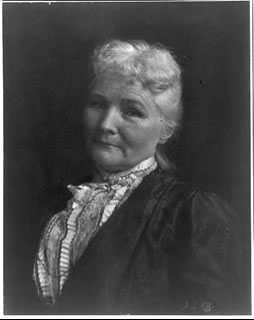
 Mary Harris "Mother Jones",
Mary Harris "Mother Jones",
Library of Congress, LC-USZ62-50377
The most famous female labor leader of the nineteenth century, Mary Harris emigrated from Ireland with her family at age five—a decade prior to the potato famine and its waves of Irish immigrants. She first worked as a teacher in a Catholic school in Michigan and then as a seamstress in Chicago. She moved to Memphis for another teaching job, and in 1861, married an ironworker named Jones (whose first name she omitted from her 1925 autobiography) and learned from him about the nascent American labor movement.
Like millions of other Irish Catholics, Mary Jones married later than the average woman, and yet she bore four children in six years before tragedy struck. Memphis, like other southern cities near water, attracted fatal mosquitoes and Mary Jones’ entire family died in the 1867 yellow fever epidemic. She dressed in black for the rest of her life.
She left the tragic city behind and returned to Chicago, again sewing for a meager living. Sorrow stalked her, however, and she lost everything she owned in the great Chicago fire of 1871. She found solace at Knights of Labor meetings, and after 1877, single-mindedly dedicated herself to improving life for working people. As the nation moved from an agrarian to an industrial economy, more and more Americans found themselves poor, for the rampant capitalism of the late nineteenth century was based on low wages and long hours—when work was to be had. Unemployment was a certainty; the economy swung wildly and workers had no pensions, health care, or other insurance. It was to these people that Mary Jones appealed, and their love and admiration for her is apparent in the appellation of “Mother Jones” by which she became known.
She first displayed her oratorical and organizing abilities in Pittsburgh during the great railroad strike of 1877; she was part of the strikes that led to the Haymarket riot in Chicago in 1886; and she even worked the textile mills of the Deep South, leading a Birmingham strike in 1894. She paused briefly to publish The New Right in 1899 and a two-volume Letter of Love and Labor in 1900 and 1901.
From that point, she concentrated most of her efforts on miners, organizing in the coal fields of West Virginia and Pennsylvania. In her late forties when she began her union cause, she lived mostly with supporters and eked out a pass-the-hat existence, but for a few years at the turn on the century (when she also turned seventy), she was actually employed by the United Mine Workers. In 1903, however, she split from UMW when the national leadership disavowed a wildcat strike in the Colorado coal fields. Mother Jones stayed in the West for a decade, working copper mines in Idaho and Arizona, and then returned to West Virginia, where she was jailed in 1913 and—at the unlikely age of eighty-three—was sentenced to twenty years in prison.
When the governor pardoned her, she returned to Colorado and was present for the Ludlow Massacre the following year. She made a national crusade of that tragedy, even lobbying President Wilson. Back on the East Coast, she participated in several industrial strikes between 1915 and 1919 that related to World War I. Even in the postwar era, when she was in her 90s, she was still actively organizing local miners.
Yet, despite her radicalism, Mother Jones was no feminist. She did not support the suffrage movement, arguing that “you don’t need a vote to raise hell.” Though she was correct when she pointed out that the women of Colorado had the vote and failed to use it to prevent the appalling conditions that led to labor violence, this should not have negated women’s inherent right to a voice in government from one who had also frequently quoted the Declaration of Independence. Indeed, Mother Jones even argued that suffragists were naïve women who unwittingly acted as duplicitous agents of class warfare; she wrote in 1925 (after national suffrage had been achieved) that “the plutocrats have organized their women. They keep them busy with suffrage and prohibition and charity.”
More significantly, Mother Jones organized working class women only in auxiliary statues and adamantly maintained that—except when the union called—a woman’s place was in the home. Her ideals reflected her Catholic heritage, for she believed that working men should be paid well enough so that women could devote themselves exclusively to motherhood. It is not surprising, therefore, that Mother Jones was conspicuously absent from the leadership of the great strikes that involved large numbers of women, for example, the 1909 Garment Industry Strike and the Lawrence Textile Strike of 1912.
She lived another five years after publishing her Autobiography of Mother Jones (1925), spending her last days with friends in Silver Spring, Maryland and dying six months after a splendid celebration of her one hundredth birthday. After ceremonious Catholic requiem, she was buried with other mine workers.
- Reprinted with permission from: Doris Weatherford. American Women's History: An A to Z of People, Organizations, Issues, and Events, (Prentice Hall, 1994), 190-191.
RELATED VIDEO










